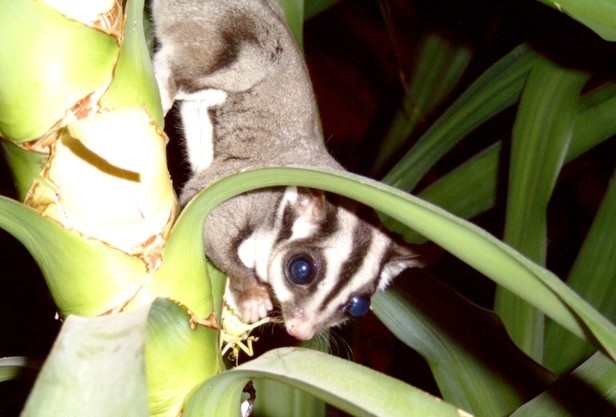- Petauridae
Taxobox
name = Petauridae

image_width = 240px
image_caption = "Petaurus breviceps "
regnum =Animal ia
phylum = Chordata
classis =Mammal ia
infraclassis =Marsupialia
ordo =Diprotodontia
superfamilia =Petauroidea
familia = Petauridae
familia_authority = C.L. Bonaparte, 1838
subdivision_ranks = Genera
subdivision = "Dactylopsila "
"Gymnobelideus "
"Petaurus "The family Petauridae includes 11 medium-sizedpossum species : fourstriped possum s, the six specieswrist-winged glider s in genus "Petaurus", andLeadbeater's Possum which has only vestigal gliding membranes. Most of the wrist-winged gliders are native toAustralia , most of the striped possums (genus "Dactylopsila ") toNew Guinea , but some members of each are found on both sides ofTorres Strait .All petaurids have obvious facial markings, a well-defined dorsal stripe, very large lower front incisors, and four-cusped molars. Despite their distinctive appearance, petaurids are closely related to the
ringtailed possum s (familyPseudocheiridae ) and are grouped together with them to form the superfamilyPetauroidea .The wrist-winged gliders are omnivorous, specialising on sap and nectar, but taking a wide variety of supplemental foods. The gliders appears to have evolved in the open forests of Australia—gliding membranes are an adaptation which aids mobility when the forest canopy is incomplete, and are of little use in
rainforest s— but now has representatives in New Guinea and many of the smaller islands nearby. Their similarities to the unrelatedflying squirrel s are an example ofconvergent evolution .The striped possums (trioks), on the other hand, are thought to have evolved on New Guinea, and the sole Australian species (the
Striped Possum ofCape York ) is considered a recent immigrant. All members of this genus are insectivores, and have specalised structures for catching insects: a heel-like structure on the wrist that is thought to be used to tap on wood to locate insect larvae. and an elongated fourth finger to extract them from their burrows.Classification
* Genus "
Dactylopsila "
**Great-tailed Triok , "Dactylopsila megalura"
**Long-fingered Triok , "Dactylopsila palpator"
**Tate's Triok , "Dactylopsila tatei"
**Striped Possum , "Dactylopsila trivirgata"
* Genus "Gymnobelideus "
**Leadbeater's Possum , "Gymnobelideus leadbeateri"
* Genus "Petaurus "
**Northern Glider , "Petaurus abidi"
**Yellow-bellied Glider , "Petaurus australis"
**Biak Glider , "Petaurus biacensis"
**Sugar Glider , "Petaurus breviceps"
**Mahogany Glider , "Petaurus gracilis"
**Squirrel Glider , "Petaurus norfolcensis"References
*MSW3 Groves|pages=53-55
Wikimedia Foundation. 2010.
